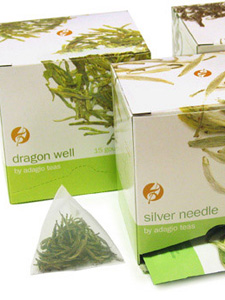Let Loose the Bags: Tea bags and Loose Tea



In this next lesson, we will tackle one of the most difficult problems facing modern tea: the popularity of inferior tea bags. Today, tea bags make up about 95% of all tea sales in the U.S. These bags, however, usually contain the cheapest tea available, producing little more than a brown-colored liquid. Doesn't sound too appetizing, huh? With this as the popular standard, it's not surprising that tea's popularity has faded.
The truth is, tea bags are a relatively new invention. When the first tea leaf fell in the legendary Shen Nung's cup in ancient China, did it have a labeled string attached? We think not. For thousands of years, tea was enjoyed in loose form, employing a variety of different methods to separate the leaves from the water. There have been several ancient books recovered that provide detailed instructions and advice on how to best enjoy tea. The most famous of these teachings was written around 800 AD by Chinese philosopher Lu Yu, called the Ch'a Ching (The Classic of Tea). As you may expect, there are no passages indicating that the tea should be "removed from the wrapper by pulling the string."
The first tea bags were actually an accident. Thomas Sullivan, a tea and coffee merchant from New York City, tried to cut sampling costs by sending loose tea in small, hand-sewn silk pouches (instead of costly tins, which was what most merchants used at the time). Potential clients, confused by this new packaging, threw the tea in hot water — bag and all. Thomas started getting many requests for these "tea bags" and realized that he had struck gold. The quick and easy clean-up of the leaves (since they were still contained in the silk bag) made it enticingly convenient. Tea bags first began appearing commercially around 1904, and quickly shipped around the world.
Unfortunately, this convenience came at a high price: flavor. Using bags created the problem of improper expansion of leaves. In order for a tea leaf to fully release its flavor, it needs a great deal of room to expand. Because teas in bags had less leg room, the quality was diminished. What was the solution? Smaller leaves. This way, they needed less room to enlarge. Due to the fact that they were hidden behind a silk screen anyway, little concern was paid to this fact.
With this decision, the slippery slope of tea began. Because size no longer mattered, merchants could purchase much cheaper grades of tea known as "fannings" or "dust." These are the lowest rankings that tea can achieve; the bottom of the tea barrels. This "tea" will certainly add color to your cup, but not nearly as much flavor. After this, companies began to wrap the "leaves" in paper filters, a much cheaper alternative that didn't allow water to flow through to the cup as easily, further reducing quality.
This state of tea mediocrity has now plagued the West for several decades. Most supermarkets still offer only bottom-of-the-barrel tea products, leaving most consumers to believe that there is nothing better available. But this is a far cry from the abundance of flavor and intoxicating aroma found in a cup of full-leaf premium tea.
Recently, tea vendors have begun brainstorming on ways to tackle this problem. How can they maintain the convenience that consumers have grown accustomed to without sacrificing the quality? One answer that they've come up with is making waves: larger leaves and larger bags. Thanks to modern technology, these companies are now able to use higher-quality bags that allows for more water to flow through, bringing more flavor to the cup.
A complete renovation of the Western mindset on tea may seem like a long shot, but remember this: there once was a time when your choices in coffee were all canned, instant and stale. Then, a few innovative and passionate roasters came along to show consumers how much better it could be. The same is true of tea. Most folks are no longer drinking instant coffee. The quality of tea in local supermarkets is finally beginning to change for the better, and Western markets are finding ways to make finer teas more accessible to the public.
 teaclass
teaclass
